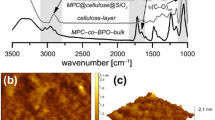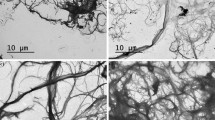Abstract
The adhesion to cellulose fibres of a strain of Pseudomonas putida isolated from a paper machine was studied under different environmental conditions. The physicochemical properties of both P. putida cells and cellulose fibres were also determined to better understand the adhesion phenomenon. Adhesion was rapid (1 min) and increased with time, cell concentration and temperature (from 25 to 40°C), indicating that bacterial adhesion to cellulose fibres is essentially governed by a physicochemical process. The P. putida cell surface was negatively charged, as shown by electrophoretic mobility measurements, and was hydrophilic due to a strong electron-donor character, as shown by the microbial adhesion to solvents method. Cellulose fibres were shown to be hydrophilic by contact angle measurements using the capillary rise method. These results suggest the importance of Lewis acid-base interactions in the adhesion process. In various ionic solutions (NaCl, KCl, CaCl2 and MgCl2), adhesion increased with increasing ionic strength up to 10–100 mM, indicating that, at low ionic strength, electrostatic interactions were involved in the adhesion process. An increase in the C/N ratio of the growth medium (from 5 to 90) decreased adhesion but this could not be related to changes in physicochemical properties, suggesting that other factors may be involved. In practice, temperature, ionic strength and nitrogen concentration must be taken into consideration to reduce bacterial contamination in the paper industry.




Similar content being viewed by others
References
Bellon-Fontaine M-N, Cerf O (1991) Mécanismes d’adhésion des microorganismes aux surfaces: facteurs influant sur l’adhésion. Ind Agric Aliment 108:13–17
Bellon-Fontaine M-N, Rault J, van Oss CJ (1996) Microbial adhesion to solvents: a novel method to determine the electron-donor/electron-acceptor or Lewis acid-base properties of microbial cells. Colloids Surf B Biointerfaces 7:47–53
Bouttier S, Khan KG, Ntsama C, Bellon-Fontaine M-N, Fourniat J (1994) Role of electrostatic interactions in the adhesion of Pseudomonas fragi and Brochothrix thermosphacta to meat. Colloids Surf B Biointerfaces 2:57–65
Briandet R, Meylheuc T, Maher C, Bellon-Fontaine M-N (1999) Listeria monocytogenes Scott A: cell surface charge, hydrophobicity, and electron-donor and acceptor characteristics under different environmental growth conditions. Appl Environ Microbiol 65:5328–5333
Busalmen JP, de Sanchez SR (2001) Influence of pH and ionic strength on adhesion of a wild strain of Pseudomonas sp to titanium. J Ind Microbiol Biotechnol 26:303–308
Cowell BA, Willcox MDP, Schneider RP (1998) A relatively small change in sodium chloride concentration has a strong effect on adhesion of ocular bacteria to contact lenses. J Appl Microbiol 84:950–958
Cowell BA, Willcox MDP, Herbert B, Schneider RP (1999) Effect of nutrient limitation on adhesion characteristics of Pseudomonas aeruginosa. J Appl Microbiol 86:944–954
Dubois M, Gilles KA, Hamilton JK, Rebers PA, Smith F (1956) Colorimetric method for determination of sugars and related substances. Anal Chem 28:350–355
Duffy G, Sheridan JJ (1997) The effect of temperature, pH and medium in a surface adhesion immunofluorescent technique for detection of Listeria monocytogenes. J Appl Microbiol 83:95–101
Fletcher M (1977) The effects of culture concentration and age, time and temperature on bacterial attachment to polystyrene. Can J Microbiol 23:1–6
Fletcher M (1980) The question of passive versus active attachment mechanisms in non-specific bacterial adhesion. In: Berkeley CW, Lynch JM, Melling J, Rutter PR, Vincent B (eds) Microbial adhesion to surfaces. Ellis Horwood, Chichester, pp 197–201
Fletcher M (1988) Attachment of Pseudomonas fluorescens to glass and influence of electrolytes on bacterium-substratum separation distance. J Bacteriol 170:2027–2030
Gélinas P, Goulet J (1983) Efficacité de huit désinfectants sur trois types de surfaces contaminées par Pseudomonas aeruginosa. Can J Microbiol 29:1715–1730
Gordon AS, Millero FJ (1984) Electrolyte effects on attachment of an estuarine bacterium. Appl Environ Microbiol 47:495–499
Harju-Jeanty P, Väätänen P (1984) Detrimental microorganisms in paper and cardboard mills. Pap Puu 3:245–259
Herald PJ, Zottola EA (1988) Attachment of Listeria monocytogenes to stainless steel surfaces at various temperatures and pH values. J Food Sci 53:1549–1562
Huang C-T, Peretti SW, Bryers JD (1994) Effects of medium carbon-to-nitrogen ratio on biofilm formation and plasmid stability. Biotechnol Bioeng 44:329–336
Hughes MC (1993) The effect of some papermaking additives on slime microflora composition. Appita J 46:194–197
Kim KY, Franck JF (1994) Effect of growth nutrients on attachment of Listeria monocytogenes to stainless steel. J Food Prot 57:720–726
Klahre J, Flemming H-C (2000) Monitoring of biofouling in papermill process waters. Water Res 34:3657–3665
Loosdrecht MCM van, Lyklema J, Norde W Schraa G, Zehnder AJB (1987) Electrophoretic mobility and hydrophobicity as a measure to predict the initial steps of bacterial adhesion. Appl Environ Microbiol 53:1898–1901
MacEldowney S, Fletcher M (1986) Effect of growth conditions and surface characteristics of aquatic bacteria on their attachment to solid surfaces. J Gen Microbiol 132:513–523
MacEldowney S, Fletcher M (1988) Effect of pH, temperature and growth conditions on the adhesion of a gliding bacterium and three nongliding bacteria to polystyrene. Microbiol Ecol 16:183–195
Mafu A, Roy D, Goulet J, Magny P (1990) Attachment of Listeria monocytogenes to stainless steel, glass, polypropylene, and rubber surfaces after short contact times. J Food Prot 53:742–746
Marshall KC, Stout R, Mitchell R (1971) Mechanism of the initial events in the sorption of marine bacteria to surfaces. J Gen Microbiol 68:337–348
Mengistu Y, Edwards C, Saunders JR (1994) Continuous culture studies on the synthesis of capsular polysaccharide by Klebsiella pneumoniae K1. J Appl Bacteriol 76:424–430
Mian FA, Jarman TR, Righelato RC (1978) Biosynthesis of exopolysaccharide by Pseudomonas aeruginosa. J Bacteriol 134:418–422
Mozes N, Marchal F, Hermesse MP, Van Haecht JL, Reuliaux L, Leonard AJ, Rouxhet PG (1987) Immobilization of microorganisms by adhesion: interplay of electrostatic and nonelectrostatic interactions. Biotechnol Bioeng 30:439–450
Oss CJ van (1994) Interfacial forces in aqueous media. Dekker, New York
Oss CJ van (1995) Hydrophobicity of biosurfaces—origin, quantitative determination and interaction energies. Colloids Surf B, Biointerfaces 5:91–110
Oss CJ van, Chaudhury MK, Good RJ (1988) Interfacial Lifshitz-van der Waals and polar interactions in macroscopic systems. Chem Rev 88:927–941
Peterson GL (1977) A simplification of the protein assay method of Lowry et al. which is more generally applicable. Anal Biochem 83:346–356
Pezron I, Bourgain G, Quere D (1995) Imbibition of a fabric. J Colloid Interface Sci 173:319–327
Pezron I, Rochex A, Lebeault J-M, Clausse D (2004) Determination of cellulose surface energy by imbibition experiments in relation to bacterial adhesion. In: Proceedings of the 17th Conference of the European Colloid and Interface Science Society (ECIS 2003), 21–26 September 2003, Florence, Italy. Poster presentation p7/8
Piette J-P, Idziak ES (1992) A model study of factors involved in adhesion of Pseudomonas fluorescens to meat. Appl Environ Microbiol 58:2783–2791
Rosenberg M (1984) Bacterial adherence to hydrocarbons: a useful technique for studying cell surface hydrophobicity. FEMS Microbiol Lett 22:289–295
Stanley PM (1983) Factors affecting the irreversible attachment of Pseudomonas aeruginosa to stainless steel. Can J Microbiol 29:1493–1499
Väisänen OM, Nurmiaho-Lassila E-L, Marmo SA, Salkinoja-Salonen MS (1994) Structure and composition of biological slimes on paper and board machines. Appl Environ Microbiol 60:641–653
Väisänen OM, Weber A, Bennasar A, Rainey FA, Busse H-J, Salkinoja-Salonen MS (1998) Microbial communities of printing paper machines. J Appl Microbiol 84:1069–1084
Vernhet A, Bellon-Fontaine M-N (1995) Role of bentonites in the prevention of Saccharomyces cerevisiae adhesion to solid surfaces. Colloids Surf B Biointerfaces 3:255–262
Williams AG, Wimpenny JWT (1980) Extracellular polysaccharide biosynthesis by Pseudomonas NCIB 11264. Studies on precursor-forming enzymes and factors affecting exopolysaccharide production by washed suspensions. J Gen Microbiol 116:133–141
Wood J M (1980) The interaction of microorganisms with ion exchange resins. In: Berkeley CW, Lynch JM, Melling J, Rutter PR, Vincent B (eds) Microbial adhesion to surfaces. Ellis Horwood, Chichester, pp 163–186
Acknowledgements
We are very grateful to Dr. Marie-Noëlle Bellon-Fontaine for her advice and helpful discussions. This work was supported by the European Economic Community contract ENV4-CT 95-0065.
Author information
Authors and Affiliations
Corresponding author
Rights and permissions
About this article
Cite this article
Rochex, A., Lecouturier, D., Pezron, I. et al. Adhesion of a Pseudomonas putida strain isolated from a paper machine to cellulose fibres. Appl Microbiol Biotechnol 65, 727–733 (2004). https://doi.org/10.1007/s00253-004-1605-7
Received:
Revised:
Accepted:
Published:
Issue Date:
DOI: https://doi.org/10.1007/s00253-004-1605-7




